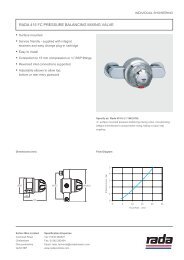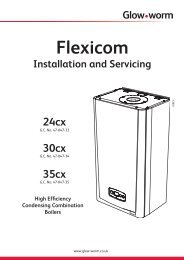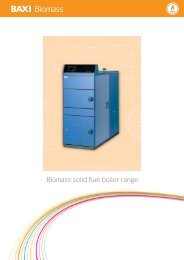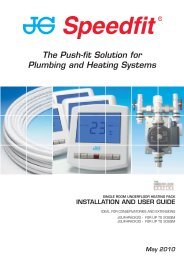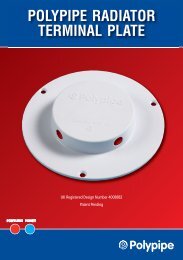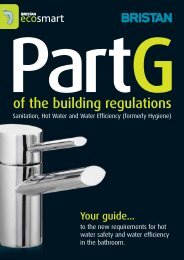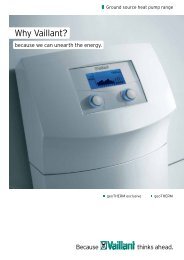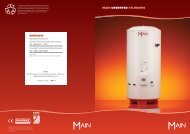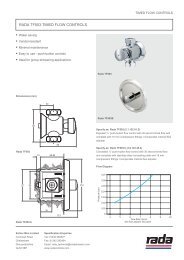Hep20 Technical Handbook
Hep20 Technical Handbook
Hep20 Technical Handbook
You also want an ePaper? Increase the reach of your titles
YUMPU automatically turns print PDFs into web optimized ePapers that Google loves.
Raw material sourcing<br />
The mining of metallic ores, which is<br />
predominantly open cast mining,<br />
results in a lasting scar on the<br />
landscape. The fraction of metal<br />
extracted from the ore (1 to 2%)<br />
exacerbates this problem.<br />
Crude oil in contrast, is extracted<br />
via a bore-hole and consequently<br />
has much less of a lasting effect on<br />
the landscape. Furthermore, almost<br />
100% of crude oil is subsequently<br />
converted into useable products,<br />
e.g. oils, fuels and chemicals.<br />
Raw material processing and<br />
pipe material production<br />
The refining and smelting of metals<br />
consumes far more energy than the<br />
refining of oil and polymerisation of<br />
plastics. The emissions from metals<br />
production processes in terms of<br />
soil, air and water pollution also far<br />
exceed the impact of oil refining and<br />
plastics polymerisation.<br />
The emissions into soil from metal<br />
refining are increased due to the<br />
large fraction of the electrical energy<br />
used for smelting being generated by<br />
coal combustion. The ore residues,<br />
together with the ashes from power<br />
production have a considerable<br />
polluting effect on the landscape.<br />
Emissions from these metal refining<br />
processes also have an impact on<br />
both water and air pollution due to<br />
the generation of sulphur dioxide,<br />
carbon dioxide, other gases and<br />
airborne particles, plus sulphates and<br />
other solid/chemical emissions. In<br />
contrast, the oil refining and plastics<br />
polymerisation processes generate<br />
very little in the way of emissions<br />
since they are essentially fully<br />
integrated processes.<br />
Pipe and fitting manufacture<br />
For both metals and plastics the<br />
production of pipes and fittings<br />
involves raising the temperature of<br />
the raw materials above their<br />
melting/softening points. The<br />
temperatures involved, however, are<br />
much higher for metals in<br />
comparison with plastics, with<br />
consequential differences in energy<br />
efficiency ratings.<br />
Pipe systems installations<br />
The weight of piping is an important<br />
factor in assessing the overall energy<br />
efficiency of the piping system. Due to<br />
their much lighter weight, plastics<br />
materials exhibit a distinct advantage<br />
over metal pipes in this respect. The<br />
total energy consumption to<br />
manufacture metal pipes required for<br />
the piping system of, for instance, a 16-<br />
family housing complex is significantly<br />
higher than for plastic pipes. Figure 33<br />
shows the total energy consumed<br />
(total weight account for) in producing<br />
the complete piping network in each<br />
of the different materials.<br />
Installation life expectancy<br />
Two considerations should be taken<br />
into account with respect to the life<br />
expectancy of a piping installation.<br />
Firstly, the lifetime of a system delays<br />
the need for replacement, and hence<br />
reduces the environmental impact on<br />
a time-dependent scale. Secondly,<br />
when a material has completed its<br />
useful applicational life, its<br />
environmental impact is reduced if it<br />
can be recycled. Both metal and<br />
polyolefin thermoplastics, including<br />
polybutylene (PB), can be recycled.<br />
However, since the plastics piping<br />
systems are expected by standards<br />
accreditation to provide a service life<br />
in excess of 50 years, it is difficult to<br />
reliably predict the environmental<br />
impact of recycling on such a long<br />
timescale.<br />
Material<br />
Copper<br />
Galv steel<br />
PVC-C<br />
PE-X<br />
PP-R<br />
Polybutylene<br />
(PB)<br />
0 5000 10000 15000 20000 25000 30000 35000<br />
Energy consumption (mega joules)<br />
Hepworth’s Doncaster manufacturing plant<br />
Figure 33 Total Energy Consumption (during manufacture/installation/use)<br />
of the Complete Piping System for a 16-Family Housing Complex<br />
93



